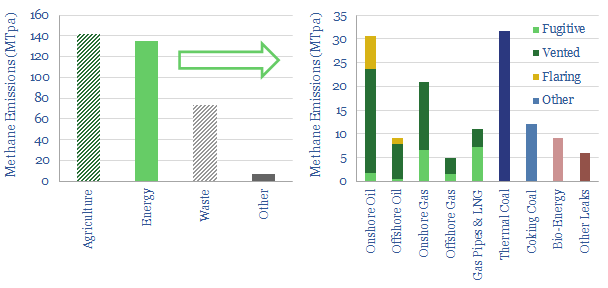Global methane emissions amount to 360MTpa. 40% is from agriculture, 40% from the energy industry and 20% from the landfill industry. Within energy, over 30% of the leaks are from coal, 30% are from oil, 27% are from gas, and 7% are bio-energy. This data-file provides context by quantifying some of the largest methane leaks of all time.
Our roadmap to net zero requires a reasoned, pragmatic focus on minimizing all methane leaks. Consider that 40% of global emissions are from agriculture. Precisely no one is arguing that the world should therefore dismantle the global agricultural complex, leaving 8 bn humans to subsist upon foraging. We need to find effective ways of minimizing and reversing the impacts of methane leaks. Our best single note on this topic is linked here.
What about super-emitters? Some sources have estimated that the worst 1-10% of leaks account for around 50% of methane leaked from the energy industry. Hence in this data-file, we have aimed to tabulate, and contextualize some of the largest methane leaks of all time. The recent Nord Stream 1-2 sabotage attacks in Europe are likely near the top of the list (chart below, left).

However, for context, the ongoing methane emissions from some of the world’s largest energy assets are likely even larger than the emissions from Nord Stream, or Aliso Canyon, or other famous blow-outs. The world’s largest oil field, or the world’s largest gas field each likely emit around 700kTpa of methane. This is because they are very, very large, producing 1%, 2% of the world’s total useful energy. Yet, on a per kWh basis, they are 10x less methane intensive than some of the methane-emitting coal mines plotted above-right.
Coal mines often leak more gas than gas assets themselves. One coal mine in Russia is said to be leaking 760kTpa. So, numerically, Nord Stream is not some kind of “climate bomb”, despite the media hysteria. This is all covered in our coal research.
In our view, one key reason to be unhappy about giant leaks like Nord Stream is not the volumes of methane being leaked. It is their pointlessness. It is pure environmental downside. At least coal mines produce coal.
Second, there are companies working hard to lower their methane emissions, especially in US shale. For example, they are replacing the pneumatic devices that tend to leak 0.01 – 10 Tpa of methane. Or they are deploying an incredible array of new sensing technologies, so they can immediately identify fugitive emissions sources, then remedy valves, seals, compressors, tanks, which in turn might leak up to 100 Tpa of methane when they fail. When faced with a choice, it would be nice if we could source supplies from ESG-positive suppliers, rather than wantonly leaky and ESG-negative suppliers.
The third reason to be unhappy about the Nord Stream 1-2 leaks is that they represent a direct attack on European infrastructure, further deepening what could be a decade-long energy shortage, a gutting of European industry. This also cements the likelihood that Europe will phase out all Russian gas by 2030, as it becomes ‘first in the firing line’ to be displaced by renewables.
An observation from compiling the data-set is that many methane-leaking events over the history of the industry are opaque. The methane leaked was never quantified. Or even today, it cannot be precisely quantified: estimates of the Nord Stream leaks range from 70kT to 500kT.
Finally, many regions with large-scale oil and gas production have no historical disclosure of large methane leaks. In our view, the most likely explanation is that the methane leaks have not been publicized. Consider, for example, that the US energy industry produces c20% of the world’s useful energy, but only c10% of the global energy industry’s methane emissions. The US is transparent. Methane leaks come to light. They get addressed. Perhaps you cannot say the same about all other countries.
Data. A useful resource estimating methane emissions, by country, by source, is the IEA’s methane emission database. The aggregation of individual large-scale leaks is our own.

